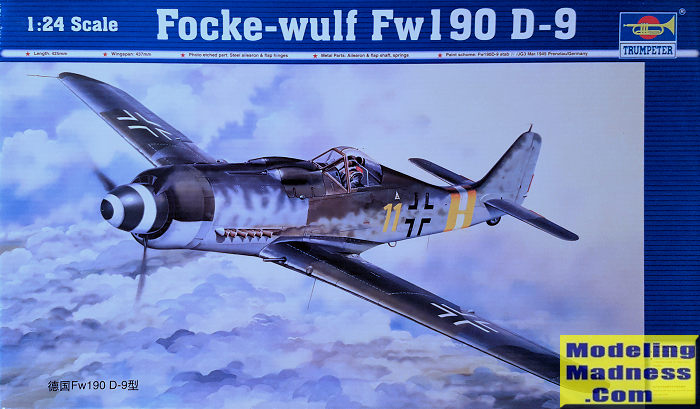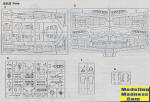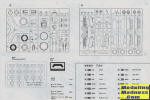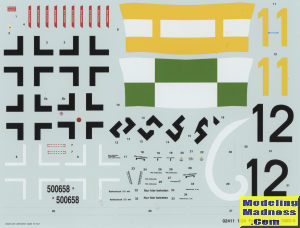
Trumpeter 1/24 FW-190D-9
| KIT #: | 02411 |
| PRICE: | $10.00 'used' |
| DECALS: | Two options |
| REVIEWER: | Scott Van Aken |
| NOTES: | 2004 tooling |

| HISTORY |
The Fw 190 D (nicknamed the Dora; or Long-Nose Dora, "Langnasen-Dora") was intended to improve on the high-altitude performance of the A-series enough to make it useful against the American heavy bombers of the era. In reality, the D series was rarely used against the heavy bomber raids, as the circumstances of the war in late 1944 meant that fighter-versus-fighter combat and ground attack missions took priority. A total of 1,805 D-9s were produced. Production started in August 1944.
The liquid-cooled 1,750 PS (1,726 hp, 1,287 kW) Jumo 213A could produce 2,100 PS (2,071 hp, 1,545 kW) of emergency power with MW 50 injection, improving performance to 426 mph (686 km/h) at 21,650 ft (6,600 m). Early D-9s reached service without the MW 50 installation, but in the meantime Junkers produced a kit to increase manifold pressure (Ladedrucksteigerungs-Rüstsatz) that increased engine output by 150 PS to 1,900 PS, and was effective up to 5,000 m (16,400 ft) altitude. It was fitted immediately to D-9s delivered to the units from September, or retrofitted in the field by TAM. By the end of December, all operational Doras, 183 in total, were converted. From November 1944, a simplified methanol water (MW 50) system (Oldenburg) was fitted, which boosted output to 2,100 PS. By the end of 1944, 60 were delivered with the simplified MW 50 system or were at the point of entering service. The 115 L tank of the Oldenburg system would hold the MW 50 booster liquid, which was single purpose, while later systems were to be dual purpose, holding either MW 50 or additional fuel.
The fighter lacked the high turn rate and higher rate of roll of its close coupled radial-engined predecessor. It was a bit faster, however, with a maximum speed of 680 km/h (422 mph) at 6,600 meters (21,650 ft). Its 2,240 horsepower with methanol-water injection (MW 50) gave it an excellent acceleration in combat situations. It also climbed and dived more rapidly than the Fw 190A, and so proved well suited to the dive-and-zoom ambush tactics favored by the Schlageter pilots. Many of the early models were not equipped with tanks for methanol, which was in very short supply in any event. At low altitude, the top speed and acceleration of these examples were inferior to those of Allied fighters. Hans Hartigs recalled that only one of the first batch of Dora 9s received by the First Gruppe had methanol water injection, and the rest had a top speed of only 590 km/h (360 mph).
Due to the failure of multiple attempts to create an effective next generation 190, as well as the comments of some Luftwaffe pilots, expectations of the Dora project were low. These impressions were not helped by the fact that Tank made it very clear that he intended the D-9 to be a stopgap until the Ta 152 arrived. These negative opinions existed for some time until positive pilot feedback began arriving at Focke-Wulf and the Luftwaffe command structure.
Sporting good handling and performance characteristics, the D-9 made an effective medium altitude, high speed interceptor, although its performance still fell away at altitudes above about 20,000 ft (6,100 m). When flown by capable pilots, the Fw 190D proved the equal of Allied types.
| THE KIT |
 The other night, at the local IPMS meeting, a friend of mine brought
in this kit and offered it to me for $10.00. He stated that the kit had been
started and that the owner of it wanted to get rid of all his big scale kits
as he knew it would never get completed. I did a cursory lo
The other night, at the local IPMS meeting, a friend of mine brought
in this kit and offered it to me for $10.00. He stated that the kit had been
started and that the owner of it wanted to get rid of all his big scale kits
as he knew it would never get completed. I did a cursory lo ok through the
box and not seeing anything really horrible, bought the kit. On bringing it
home, I discovered that about 40% of the kit had been assembled. The
assembly was good though nothing had been prepainted. It included the
complete engine minus the accessory section, the interior, main wings, and
the tailplanes. He has started to build the forward cowling and had
assembled the open cowling option. Comparing what was left on the sprues,
the only thing I found missing was the gun sight. $10.00 well spent.
ok through the
box and not seeing anything really horrible, bought the kit. On bringing it
home, I discovered that about 40% of the kit had been assembled. The
assembly was good though nothing had been prepainted. It included the
complete engine minus the accessory section, the interior, main wings, and
the tailplanes. He has started to build the forward cowling and had
assembled the open cowling option. Comparing what was left on the sprues,
the only thing I found missing was the gun sight. $10.00 well spent.  cowling pieces are installed (there are two
different gun cover pieces to choose from), the prop and supercharger intake
assembled and attached along with the clear bits and various antennas, and
you are done.
cowling pieces are installed (there are two
different gun cover pieces to choose from), the prop and supercharger intake
assembled and attached along with the clear bits and various antennas, and
you are done.| CONCLUSIONS |
This isn't the first time I've bought a started kit and I do like the subject. It is very much 'old' Trumpeter tooling and I'm sure there are errors. The lack of info as to the exact parts to use on the two markings options makes the optional parts a bit of a guessing game. One thing for sure, the finished result will be large.
June 2022 Copyright ModelingMadness.com. All rights reserved. No
reproduction in part or in whole without express permission from the editor. If you would like your product reviewed fairly and fairly quickly, please
contact
the editor
or see other details in the
Note to
Contributors.